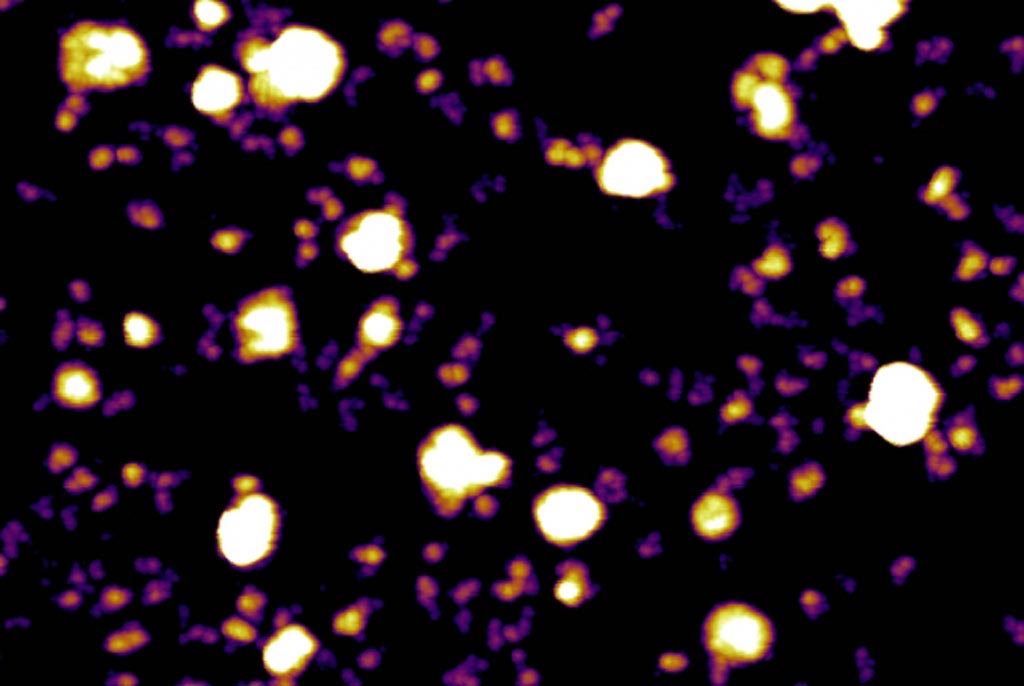Cancer Progression Linked to Activity of Exosomes and Exomeres
By LabMedica International staff writers
Posted on 08 Mar 2018
The separation technique asymmetric flow field-flow fractionation (AF4) was used to identify and characterize two distinct exosome subpopulations, and the method enabled discovery of an abundant population of non-membranous nanoparticles termed "exomeres."Posted on 08 Mar 2018
Exosomes are cell-derived vesicles that are present in many and perhaps all biological fluids, including blood, urine, and cultured medium of cell cultures. The reported diameter of exosomes is between 30 and 100 nanometers, which is larger than low-density lipoproteins but much smaller than red blood cells. Exosomes, which contain RNA, proteins, lipids, and metabolites that are reflective of the cell type of origin, are either released from the cell when multivesicular bodies fuse with the plasma membrane, or they are released directly from the plasma membrane. Exosomes have specialized functions and play a key role in coagulation, intercellular signaling, and waste management. Consequently, there is a growing interest in the clinical applications of exosomes for prognosis, therapy, and as biomarkers for health and disease.

Image: Atomic force microscopy image of exosomes (white ball-like structures) and exomeres (purple and yellow) secreted by melanoma tumor cells (Photo courtesy of Molecular Cytology Core Facility, Memorial Sloan Kettering Cancer Center).
The heterogeneity of exosomal populations has hindered understanding of their biogenesis, molecular composition, biodistribution, and functions. To study exosomes, investigators at Weill Cornell Medicine (New York, NY, USA) employed asymmetric flow field-flow fractionation (AF4). AF4 is a fractionation method used for the characterization of nanoparticles, polymers and proteins, which is based on the theory of field flow fractionation. Field flow fractionation (FFF) is based on laminar flow of particles in a solution. These sample components will change levels and speed based on their size/mass. Since these components will be travelling at different speeds, separation occurs AF4 is distinct from FFF because it contains only one permeable wall so the crossflow is caused only by the carrier liquid. The crossflow is induced by the carrier liquid constantly exiting by way of the semi-permeable wall on the bottom of the channel.
The investigators reported in the February 19, 2018, online edition of the journal Nature Cell Biology that by employing the AF4 technique, they identified two exosome subpopulations (large exosome vesicles, Exo-L, 90–120 nanometers; small exosome vesicles, Exo-S, 60–80 nanometers) and discovered an abundant population of non-membranous nanoparticles termed "exomeres" (approximately 35 nanometers).
Exomere proteomic profiling revealed that there was enrichment in metabolic enzymes and hypoxia, microtubule, and coagulation proteins as well as specific pathways, such as glycolysis and mTOR signaling. Exo-S and Exo-L contained proteins involved in endosomal function and secretion pathways, and mitotic spindle and IL-2/STAT5 signaling pathways, respectively. Exo-S, Exo-L, and exomeres each had unique N-glycosylation, protein, lipid, DNA, and RNA profiles and biophysical properties. These three nanoparticle subsets demonstrated diverse organ biodistribution patterns, suggesting distinct biological functions.
"We found that exomeres are the most predominant particle secreted by cancer cells," said senior author Dr. David Lyden, professor of pediatric cardiology at Weill Cornell Medicine. "They are smaller and structurally and functionally distinct from exosomes. Exomeres largely fuse with cells in the bone marrow and liver, where they can alter immune function and metabolism of drugs. The latter finding may explain why many cancer patients are unable to tolerate even small doses of chemotherapy due to toxicity."
"Cancer is truly a systemic disease that requires multi-organ involvement to progress," said Dr. Lyden. "Our finding that tumor cells secrete these three distinct nanoparticles, that then target cells in different organs reflects this important aspect of the disease. Based on our findings, the next phase will be to measure exosomes and exomeres in plasma samples to help predict organs that may be targeted for metastasis during tumor progression. This will help us better understand the biology of cancer, guide therapeutic decisions and develop novel therapies."













